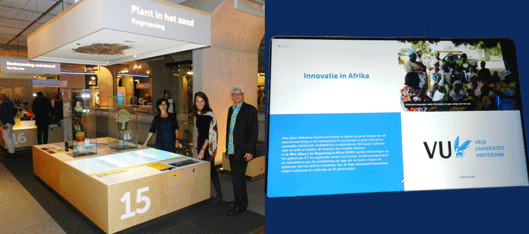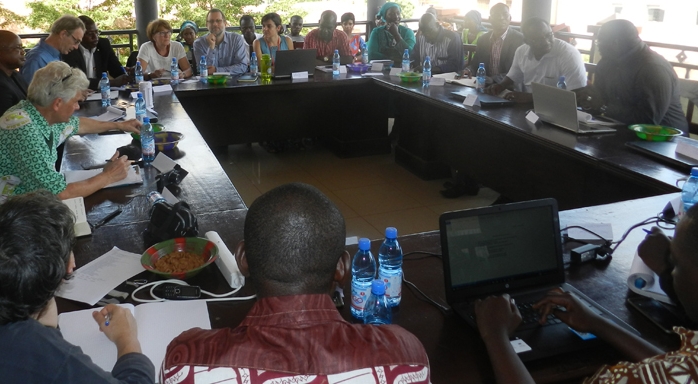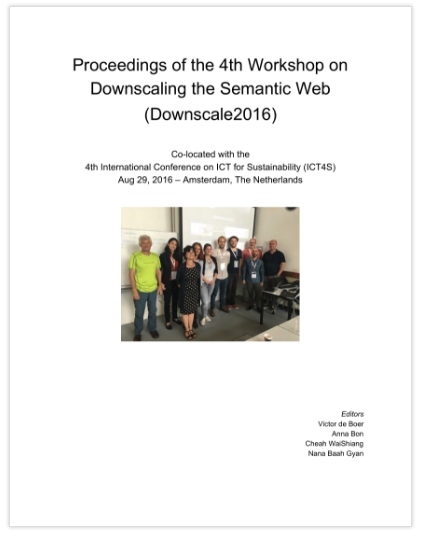For its 10th anniversary, the Web Science Trust organized an event Webscience@10. For this event, a Webscience@10 TV channel was launched to showcase different research and education initatives around the world. On behalf of the VU Network Institute and W4RA, we submitted our Web of Voices video as well as a short introduction to the W4RA team.
ICT4D
W4RA research displayed in Museon
In modern day research, dissemination is key and it is therefore always nice to see research results being shared with the public in new and unforseen ways. Our work within the Web for Regreening in Africa (W4RA) is now part of a exhibition in the Museon museum in the Hague. The exhibition focuses on the United Nations’ 17 Sustainable Development Goals (SDGs) for 2030. As content partner of the Museon, the W4RA programme of VU has contributed ideas, visuals and texts for the exposition related to SDG No. 15, entitled “Plant in het Zand” (Plant in the sand).
From the press release: Land degradation and desertification are increasing due to both natural and human causes, including climate change and population pressures. Areas can no longer meet the needs of their populations, with famine and poverty as a result. There are various solutions, but regreening – the natural (re)generation and protection of trees by local farmers themselves – is a highly successful one. Belts of trees act as windbreaks, helping to stop soil blowing away, keeping it moist for longer, and providing a micro-climate that is better for people, animals and plants. Trees also provide food and many other economically useful products.
Within the W4RA programme, we integrate local ICT web and mobile app innovations to support local knowledge sharing around regreening efforts.
VU looking further in Mali
[This post by Anna Bon is cross-posted from W4RA.org. See also the VU press release: VU looking further in Mali]
On 13 October 2016, the W4RA team organized and co-chaired, a Green Climate Funds workshop together with Malian farmer organization AOPP (l’Association des Organisations professionnelles paysannes). The objective of the meeting was to form a consortium and prepare a project plan, which will be submitted in the framework of this United Nations program.
The workshop was attended by representatives from the Dutch Embassy, the Swedish and Norwegian embassies, and by development (donor) agencies from the EU, Germany, the United Nations Capital Development Fund, the Global Environment Facility (GEF) and a range of Malian and Dutch development organizations.

Mali is one of the poorest countries in the world, plagued by the effects of climate change and a civil war in the northern regions. The effects of land degradation and desertification are a serious threat to the food security of millions of people, especially those living in rural regions.
Recently, the United Nations prioritized its support to Mali in the framework of the Green Climate Funds, a new programme to fight the effects of climate change on global scale. In response to a call for proposals, organizations in Mali are forming consortia, to prepare project proposals for funding by the Green Climate Funds.
Through ongoing interdisciplinary research collaboration, W4RA has obtained extensive experience in socio-technical field-based action research in West Africa. Building on partnerships with local partners (AOPP, Sahel Eco and Radio Rurale – Mali, Réseau MARP -Burkina Faso, University for Development Studies – Ghana) VU’s research programme W4RA wants to contribute to regreening, local knowledge sharing, local innovation and emerging rural agro-forestry value chains.
Meanwhile the W4RA is training students, through community service education, in rural Africa. This is done through the ICT4D master course (artificial intelligence, information science, computer science,) and various master research projects (Network Institute Academy assistants, various master research projects).
Downscale2016 proceedings published
 I chose to publish the proceedings of Downscale2016 using Figshare. This gives a nice persistent place for the proceedings and includes a DOI. To cite the proceedings, use the text below. The proceedings is published using the CC-BY license.
I chose to publish the proceedings of Downscale2016 using Figshare. This gives a nice persistent place for the proceedings and includes a DOI. To cite the proceedings, use the text below. The proceedings is published using the CC-BY license.
Victor de Boer, Anna Bon, Cheah WaiShiang and Nana Baah Gyan (eds.) Proceedings of the 4th Workshop on Downscaling the Semantic Web (Downscale2016). Co-located with the 4th International Conference on ICT for Sustainability (ICT4S) Sep 1, 2016, Amsterdam, The Netherlands. doi:10.6084/m9.figshare.3827052.v1
A look back at Downscale2016
On 29 August, the 4th International Workshop on Downscaling the Semantic Web (Downscale2016) was held as a full-day workshop in Amsterdam co-located with the ICT4S conference. The workshop attracted 12 participants and we received 4 invited paper contributions, which were presented and discussed in the morning session (slides can be found below). These papers describe a issues regarding sustainability of ICT4D approaches, specific downscaled solutions for two ICT4D use cases and a system for distributed publishing and consuming of Linked Data.. The afternoon session was reserved for demonstrations and discussions. An introduction into the Kasadaka platform was followed by an in-depth howto on developing voice-based information services using Linked Data. The papers and the descriptions of the demos are gathered in a proceedings (published online at figshare: doi:10.6084/m9.figshare.3827052.v1).

During the discussions the issue of sustainability was addressed. Different dimensions of sustainability were discussed (technical, economical, social and environmental). The participants agreed that a holistic approach is needed for successful and sustainable ICT4D and that most of these dimensions were indeed present in the four presentations and the design of the Kasadaka platform. There remains a question on how different architectural solutions for services (centralized, decentralized, cloud services) relate to eachother in terms of sustainability and when a choice for one of these is most suited. Discussion then moved towards different technical opportunities for green power supplies, including solar panels.
The main presentations and slides are listed below::
- Downscale2016 introduction (Victor and Anna) (slides)
- Jari Ferguson and Kim Bosman. The Kasadaka Weather Forecast Service (slides)
- Aske Robenhagen and Bart Aulbers. The Mali Milk Service – a voice based platform for enabling farmer networking and connections with buyers. (slides)
- Anna Bon, Jaap Gordijn et al. A Structured Model-Based Approach To Preview Sustainability in ICT4D (slides)
- Mihai Gramada and Christophe Gueret Low profile data sharing with the Entity Registry System (ERS) (slides)
A Mobile App for Sign Language Learning in Sub-Saharan Africa
[This post by Julia Salomons describes her Computer Science Master project]
‘Communication is key’ a phrase known worldwide, it is how people exchange ideas, knowledge, feelings, thoughts and much more. Communication between people comes in all different forms: verbal, visual or electronic to name a few. For many choosing which form of communication they wish to communicate in is an option. However, when someone suffers from hearing loss they tend to lose the option to choose.

Depending where you are in the world, the support and care that is available to those who are deaf can vary greatly. In developing regions such as Sub-Saharan Africa (SSA) the support and care varies within the region, from acceptance to rejection. Where on one end of the spectrum, acceptance, individuals are allowed to express themselves how they want whereas on the other end individuals are trapped in their environment. Where some cases they fear for their lives.
The problem that was uncovered during our research showed us that there was a lack of communication between hearing and deaf individuals. Deaf individuals who were lucky enough to attend school or gain support from the government or organisations, learned how to communicate through sign language. However, even with the ability to communicate the communication with other deaf individuals is where the communication stops, which increases the gap between deaf and hearing individuals. This project focused on decreasing that gap, by creating an educational mobile application, Learn to Sign, which would assist hearing individuals learn sign language.
To get a good look at the application, watch a screencast of the application on Youtube or visit the project site at https://learn2signsite.wordpress.com/, where you can download the application. You can also download the thesis itself here.
Msc project: Low-Bandwith Semantic Web
[This post is based on the Information Sciences MSc. thesis by Onno Valkering]
To make widespread knowledge sharing possible in rural areas in developing countries, the notion of the Web has to be downscaled based on the specific low-resource infrastructure in place. In this paper, we introduce SPARQL over SMS, a solution for exchanging RDF data in which HTTP is substituted by SMS to enable Web-like exchange of data over cellular networks.

The solution uses converters that take outgoing SPARQL queries sent over HTTP and convert them into SMS messages sent to phone numbers (see architecture image). On the receiver-side, the messages are converted back to standard SPARQL requests.
The converters use various data compression strategies to ensure optimal use of the SMS bandwidth. These include both zip-based compression and the removal of redundant data through the use of common background vocabularies. The thesis presents the design and implementation of the solution, along with evaluations of the different data compression methods.

The application is validated in two real-world ICT for Development (ICT4D) cases that both use the Kasadaka platform: 1) An extension of the DigiVet application allows sending information related to veterinary symptoms and diagnoses accross different distributed systems. 2) An extension of the RadioMarche application involves the retrieval and adding of current offerings in the market information system, including the phone number of the advertisers.
For more information:
- Download Onno’s Thesis. A version of the thesis is currently under review.
- The slides for Onno’s presentation are also available: Onno Valkering
- View the application code at https://github.com/onnovalkering/sparql-over-sms
Kasadaka 1.0
[This post is based on Andre Baart’s B.Sc. thesis. The text is mostly written by him]

In developing (rural) communities, the adoption of mobile phones is widespread. This allows information to be offered to these communities through voice-based services. This research explores the possibilities of creating a flexible framework (Kasadaka) for hosting voice services in rural communities. The context of the developing world poses special requirements, which have been taken into account in this research. The framework creates a voice service that incorporates dynamic data from a data store. The framework allows for a low-effort adaptation to new and changing use cases. The service is hosted on cheap, low-powered hardware and is connected to the local GSM network through a dongle. We validated the working and flexibility of the framework by adapting it to a new use case. Setting up this new voice server was possible in less than one hour, proving that it is suitable for rapid prototyping. This framework enables further research into the effects and possibilities of hosting voice based information services in the developing world. The image below shows the different components and the dataflow between these components when a call is made. Read more in Andre Baart‘s thesis (pdf).
All information on how to get started with Kasadaka can be found on the project’s GitHub page: https://github.com/abaart/KasaDaka

Text in italics only takes place when setting up the call.
- Asterisk receives the call from the GSM dongle, answers the call, and connects it to VXI.
Asterisk receives the user’s input and forwards it to VXI. - VXI requests the configured VoiceXML document from Apache.
VXI requests the configured VoiceXML document from Apache. Together with the request, it sends the user input. - Apache runs the Python program (based on Flask), in which data from the triple store has to be read or written. Python sends the SPARQL query to ClioPatria.
- ClioPatria runs the query on the data present, and sends the result of the query back to the Python program.
- Python renders the VoiceXML template. The dynamic data is now inserted in the VoiceXML document, and it is sent back to VXI.
- VXI starts interpreting the VoiceXML document. In the document there are references to audio files. It sends requests to Apache for the referenced files.
- Apache sends a request for the file to the file system.
- The file is read from the file system.
- Apache responds with the requested audio files.
- VXI puts all the audio files in the correct order and plays them back sequentially, sending the audio to the GSM dongle.
This cycle repeats until the call is terminated.
Inviting submissions to Downscale2016
The Fourth International Workshop on Downscaling the (Semantic) Web (Downscale2016) will be co-located with the 4th International Conference on ICT for Sustainability (ICT4S). The workshop will be Aug 29 in Amsterdam, The Netherlands.
Downscale2016 follows success of previous Downscale workshops and will mostly focus on appropriate infrastructures. Instead of using large-scale centralised approaches to data management we look at breaking data-centric architectures into smaller components that consume less electricity, be cheaper to own, and more flexible than a “big server” while still mimicking, as a swarm, the features one such big server would provide. As such, the workshop matches ICT for Development (ICT4D) goals with ICT for Solutions (ICT4S) and we expect that the dialogue between ICT4S, Semantic Web and ICT4D researchers and practitioners will further each of the research fields.
We are currenty inviting both short papers (6 pages) or abstracts (2 pages) describing current or latebreaking research in ICT4D. These papers will undergo a light review procedure. For more information, visit the workshop web page.
2nd TMT Workshop in Bamako

From 7-9 May 2016, the second TMT-AOPP workshop was held in Bamako, Mali. This workshop was held in the context of the Tailor Made Training project that VU Amsterdam participates in together with the Malinese farmer organization Association des Organisations Professionnelles Paysannes (AOPP).
During the workshop, which was attended by around 25 AOPP members from all over Mali, we followed up on the results of a previous workshop in 2015, where we co-developed a number of use cases around improving the lives of rural farmers in Mali. Specifically, we developed two prototypes services accessible using simple mobile phones:
- An online marketplace for seeds. Farmers can call in to the system to place offerings of seeds or browse current offers of seeds of various quality levels in a specific region.
- A chicken vaccination service. For this service, an extension worker can register newly born chickens in the system. The system keeps an administration of when farmers need to vaccinate their chickens against specific diseases. The system then calls the farmer and plays a reminder message in his/her language.
 These services were developed on Kasadaka, the cheap and low-resource rapid-prototyping platform for knowledge-rich and voice-accessible services. During the workshop we were able to further test the Kasadaka in the field. A field trip to local farmers and a milk cooperation in nearby Ouelessebougou gave us further context and information in how these services can support locals (see also the video embedded below). Chris van Aart from 2coolmonkeys demonstrated his progress on the Senepedia wiki and two Android applications that allow farmers and organizers to use geo-services to count cows, trees or other objects in the field.
These services were developed on Kasadaka, the cheap and low-resource rapid-prototyping platform for knowledge-rich and voice-accessible services. During the workshop we were able to further test the Kasadaka in the field. A field trip to local farmers and a milk cooperation in nearby Ouelessebougou gave us further context and information in how these services can support locals (see also the video embedded below). Chris van Aart from 2coolmonkeys demonstrated his progress on the Senepedia wiki and two Android applications that allow farmers and organizers to use geo-services to count cows, trees or other objects in the field.

In addition to these two services, we also presented seven services on the Kasadaka, developed by students of the VUA ICT4D M.Sc. course. These included a weather information service, two vetirenary services, general-purpose knowledge sharing platforms, farmer alert services and a milk market. These services were all very well received and allowed the workshop participants to really see the full potential of voice-enabled information services.
The presentation below shows more information, my personal highlights from the workshop (hence the title) as well as feedback received on the seven student projects.
https://www.youtube.com/watch?v=EAoXpvkdx5w